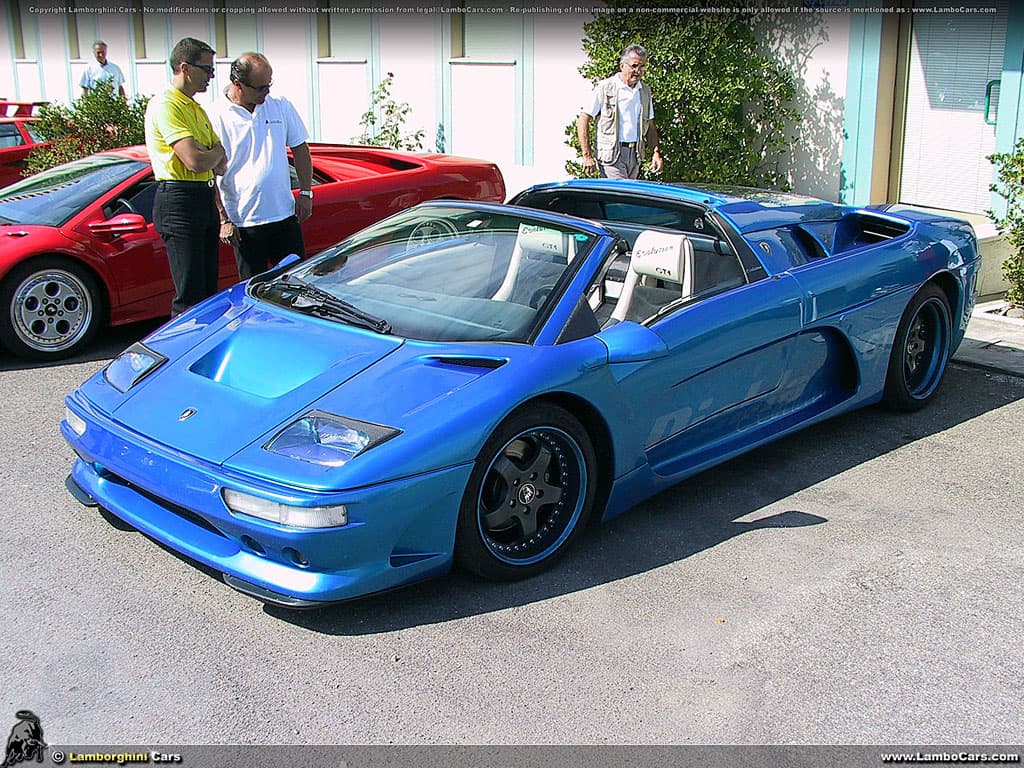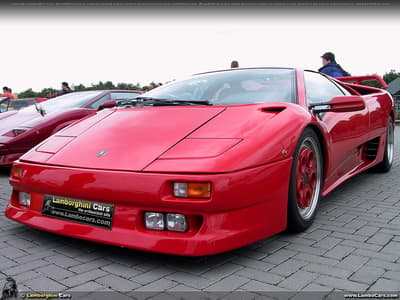In 1997 Roland Affolter showed a new Diablo recreation, the Diablo Evolution GT1.
This time he completely redesigned the car, not only mounting a new front and rear bumper, but changing just about everything he missed the first time.
Roland Affolter could already install an electrically powered roof for the Roadster, mount Carbon Fibre panels in the interior, match the leather of the upholstery, tinted in the mass, so no discoloring could happen. Another nice touch was the option of opening the doors, not just unlocking but really opening, the doors and starting the engine by remote control.
Another option could be a supercharger or even a twin-turbo configuration in the engine bay of the Diablo, pumping out up to 630 Bhp, because of the exquisite workmanship and finish of his cars, Affolter had a very close and unique relationship with Automobili Lamborghini in Sant’Agata, Italy. Rumors have gone round that the official Diablo GT2 was in fact designed by Roland Affolter.
The Evolution GT1 was in fact the first complete restyling of the Diablo, every body panel was redesigned or replaced by a new one, but also the engine compartment was worked over, he redesigned the intakes, optimized the exhaust manifold and reprogrammed the electronic fuel injection system. Again he mounted four exhaust pipes centrally at the rear, but this time the exhaust used were racing type ones, which sounded really nice when driving, a very low growling sound was made at idle, which could rise to a high pitched one at full throttle, every gear change was followed by four 30 cm flames blowing out of these pipes, caused by the two turbo’s mounted on the engine.
The basic styling of the Diablo was still recognizable, but that’s it, the front was again completely redesigned, he removed the pop-up headlights and mounted an air-intake on the front hood, doubling as a down force spoiler. Then he enlarged the front track by 7 cm so the front wings could be enlarged with another 11 cm. The external rear view mirrors were incorporated into these front wings and were no longer attached to the swing up doors.
However probably the biggest work went into the sides of the car, the side air-intakes were enlarged, but mounting them caused cutting a piece from the door and restyling the rear wheel arches, while he was already working on these body parts, he also moved the fuel nozzle and replaced it by a racing type unit, which he mounted just in front of the upper rear air intake.
By the way, the aluminum roof panel was replaced by a tinted glass panel, giving the optical illusion that the front windscreen ran further into the roof and stopped only just in front of the two roof mounted air intakes. Actually this glass panel does look a little like the one on the Cala prototype.
Similar to his previous Diablo, the rear bumper was replaced by a fully integrated one, showing the four central mounted exhausts and using a honeycomb grille with Diablo GT1 lettering. The rear lights were again set in Carbon Fibre as was the part between them, covering the two lights under it. The same design was used for the adjustable carbon fibre rear wing.
On the GT1 Affolter also attacked the interior of the car, on his yellow prototype, he mounted a two-tone leather interior combining black and yellow, showing the Raging Bull on the head rests. The dashboard was completely redesigned, integrating a passenger airbag and using the nicest Carbon Fiber available, a complete multimedia system was built into the dash, a full Alpine HiFi installation with CD-changer with Sub-woofer using multiple amplifiers, a GPS system, a color TV set and a camera system for backing up was also available.
The GT1 was built only on demand at half the price of a McLaren F1, but with four small turbo’s mounted giving the same power as the F1, and to make things even better, Affolter even built an Evolution GT1 Roadster edition, open top motoring with even more exotic looks than the standard Lamborghini Roadster.
Engine : V-12 Twin-turbo (a quad-turbo version was also available
Max. Power : 630 Bhp (650 Bhp on the quad-turbo version)
Front track : 1960 mm
Rear track : 2020 mm
Wheels front : 10,5 x 18 inch Rear : 13,5 x 18 inch three-piece rims
Tires front : 285/30 ZR 18 Rear : 335/30 ZR 18 Pirelli P Zero
Max. Speed : 345 Km/h.
0 – 100 Km/h. : 3,5 sec.



